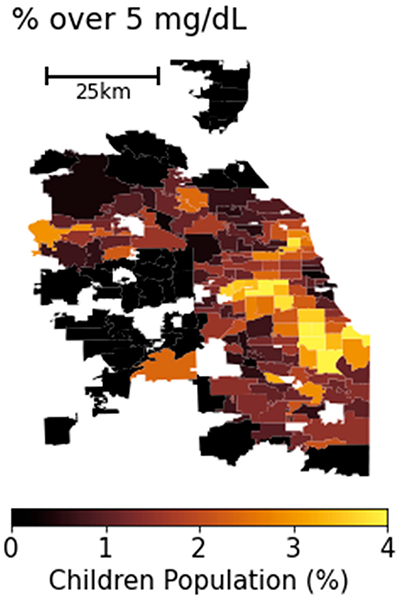How income, housing age, and urban heat affect children’s health.
The Science
A team of researchers studied why children in different Chicago neighborhoods have high blood lead levels (BLLs). Using data from 2019 to 2021, the team found lower income, higher unemployment, and older housing increase lead exposure, and hotter nighttime temperatures, common in urban areas, are linked to more lead poisoning (LP) cases. Black and Hispanic/Latino children are most affected. These insights can help create better public health policies to protect vulnerable children.

Map of percentage of children with over 5 micrograms per deciliter of blood lead levels in the Chicago area from 2019 to 2021, aggregated at the zip code level.(Reprinted under a Creative Commons Attribution 4.0 International License (CC BY 4.0) from Lee, J., and M. Hu. “Effect of Environmental and Socioeconomic Factors on Increased Early Childhood Blood Lead Levels: A Case Study in Chicago.” International Journal of Environmental Research and Public Health 21(4), 383 (2024). DOI:10.3390/ijerph21040383.)
The Impact
Children in poorer, older neighborhoods in Chicago are more likely to suffer from LP. Higher nighttime temperatures also contribute to this problem. This highlights the need for targeted health strategies to reduce lead exposure, especially for Black and Hispanic/Latino communities. Understanding these risk factors can improve children’s health and safety.
Summary
This study investigates the prevalence of elevated BLLs in children across Chicago zip codes from 2019 to 2021, linking them to socioeconomic, environmental, and racial factors. Using Wilcoxon tests and generalized additive model regressions, researchers identified economic hardship—measured by per capita income and unemployment rates—as a significant factor in increased LP rates. Additionally, higher LP rates were associated with older buildings, particularly those constructed before the 1978 lead paint ban, demonstrating the impact of historical policies on current health outcomes.
A novel aspect of this study is the examination of land surface temperature (LST) effects on LP, revealing that higher nighttime LST, indicative of urban heat island effects, correlates with increased LP rates. This connection is particularly relevant in the context of anthropogenic climate change. A racial disparity analysis showed that Black and Hispanic/Latino populations experience higher LP rates, largely due to factors such as unemployment and older housing. These findings emphasize the need for targeted public health interventions tailored to specific challenges faced by at-risk communities.
PRINCIPAL INVESTIGATOR
Max Berkelhammer
University of Illinois–Chicago
[email protected]
PROGRAM MANAGER
Sally McFarlane
U.S. Department of Energy,
Biological and Environmental Research (SC-33)
Urban Integrated Field Laboratories
[email protected]
Funding
This material is based upon work supported by the U.S. Department of Energy, Office of Science, Biological and Environmental Research program’s Urban Integrated Field Laboratories Community Research on Climate and Urban Science research activity under Award Number DE-SC0023226.
References
Lee, J., and M. Hu. “Effect of Environmental and Socioeconomic Factors on Increased Early Childhood Blood Lead Levels: A Case Study in Chicago.” International Journal of Environmental Research and Public Health 21 (4), 383 (2024). https://doi.org/10.3390/ijerph21040383.



